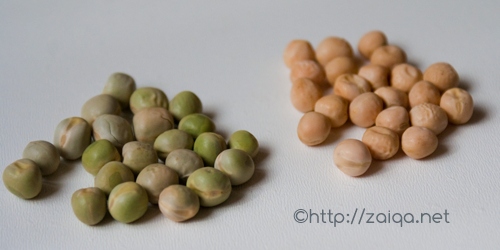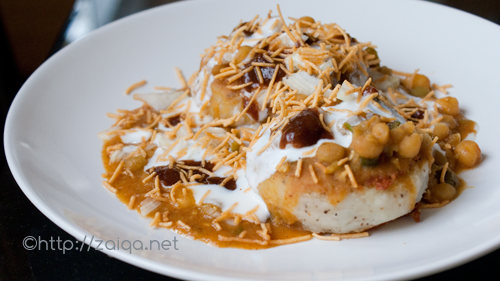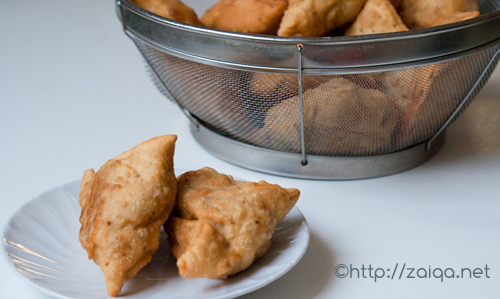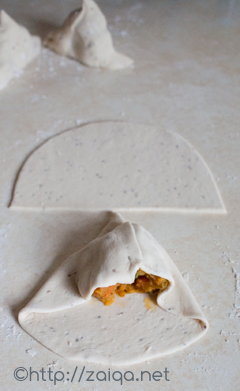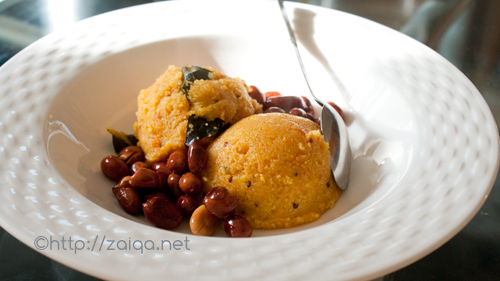Regular readers of my blog might be familiar with my love for gardening. Ever since I landed here, I have always maintained a little garden come spring/summer until fall, consisting of a few basic veggies and herbs. This has been my annual spring-summer ritual that gives me immense joy. Among them all, one herb that I always plant is Mint. I love the aroma and flavor of mint, also called as pudinah in Urdu.

store bought bunch of mint leaves from an Indian store,
this is Indian variety of Mint
Alluring aroma, bright green and crinkly opposite leaves with brownish square stems are some of the characteristic features of mint plant. There exist dozens of varieties of this hardy perennial. Out of all, I usually buy and use the kind available in the Indian grocery stores for my cooking. And at times I make do with spearmint which according to me is the closest of the Indian mint in flavor.

plucked Indian variety mint leaves
To grow Mint:
Growing mint from other healthy stems is very easy. There are two ways to grow your own mint.
1. One way is to grow them through store brought saplings.
2. The other way is to grow them from stem cuttings.
1. Buy your favorite variety of mint saplings from the garden centers or nurseries or from some friendly gardeners, and transfer them to wide and deep pots. I usually buy Spearmint or Peppermint or Indian mint. Place outdoors during spring/summer and water daily. Mint loves moist soil and grows vigorously once established. Keep snipping off the tips from time to time and use them in your cooking to promote a bushy growth and avoid flowering.
2. To grow mint from stem cuttings:
I always choose mint sprigs to be used as cuttings from Indian stores, as I find their tatse to be strong and synonymous to Indian culinary preparations. You can choose any variety you like. Just cleanly snip off two sets of opposite leaves from the bottom and leave the remaining at the growing tip. Make a clean diagonal cut just below the bottommost node, and plant the cutting in soil in a small container, or you can also place the cutting in a bowl/container with fresh cool water, such that the bottommost node is covered with soil or with water, in a bright area at room temperature that receives plenty of indirect sunlight.

stem cuttings of fresh & healthy Indian variety mint
placed in a glass with some fresh cool water so that they root
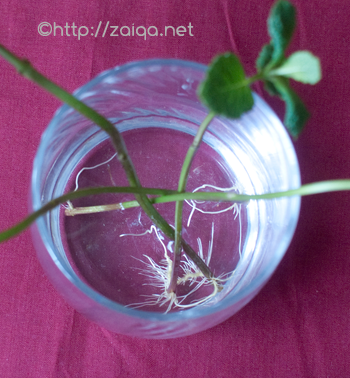
stem cutting beginning to root
In a week or two you will notice that the stem cuttings will start to root and develop new leaves. These roots are very fragile. Transfer these stems to a large and deep containers and place in a partly sunny area outdoors. Keep watering regularly whenever the soil looks dry. Soon you will have enough mint to share with your neighbors. Pinch back mint tips which make beautiful garnishes, or as required. This helps to keep the plant bushy and delay flowering.
Good to Know:
I advise growing mint only in large sized pots, tubs or containers and never in ground, as it invasive and quickly spreads out like a weed taking over your entire lawn or garden. Growing mint from seed is difficult, therefore I only recommend buying small seedlings from nursery or garden centers during early spring or use a stem cutting from the store brought mint you use for cooking. If during winters it gets very cold and snows in your area, then mint will die, but do not fret, it revives once winter ends. Bring the mint pots indoors during winters and place in front of windows that receives some bright daylight. Do not crowd several varieties a single pot/container. Mint prefers partly sunny areas and a moist soil, water it frequently whenever the soil looks dry.

Indian Mint growing luxuriously outdoors in a pot on the deck
To Store Mint:
Fresh is best when it comes to mint or any herbs. Buy one can always store it by either freezing the leaves or by drying them. I do not like to dry them.
1. To store fresh leaves, make a fresh cut below each stem and place the stems in a glass. Pour a little amount of fresh cool water into the glass that acts like a vase, taking care the water does not touch any leaves. Place it on the kitchen countertop in an area away from harsh sunlight. Change the water daily. This way, the stems will root which you can also use to plant the mint, and the leaves will stay fresh for a about 2-3 weeks.
2. An another way to store fresh mint is to pluck all leaves and store them covered in a zip-lock bag or container lined with paper towel in the refrigerator until needed.
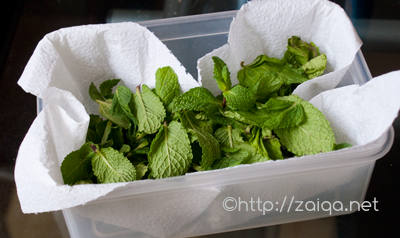
plucked mint leaves
This way the mint will stay fresh for about a week or two maximum.
3. I also freeze chopped mint, just like I do with fresh cilantro. This way you can store fresh mint indefinitely and you can add it to curries whenever you need it.
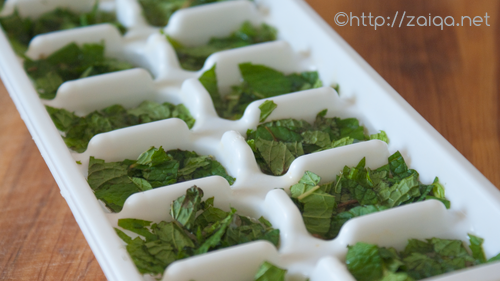
chopped mint in ice-cube tray ready to be freezed
Wash the mint leaves in fresh cool water. Spread on a kitchen towel and let dry for 30 minutes. Now chop all the mint leaves roughly. In an ice-cube tray, tightly pack roughly chopped mint into each of the molds of the tray. Cover with water and freeze overnight. The next day, working quickly, unmold the frozen mint cubes from the ice-cube tray and transfer them to a zip-lock bag. Squeeze out air from the bag and freeze immediately. To use, add the frozen cubes to the curries during the last stages of cooking.
Luv,
Mona

